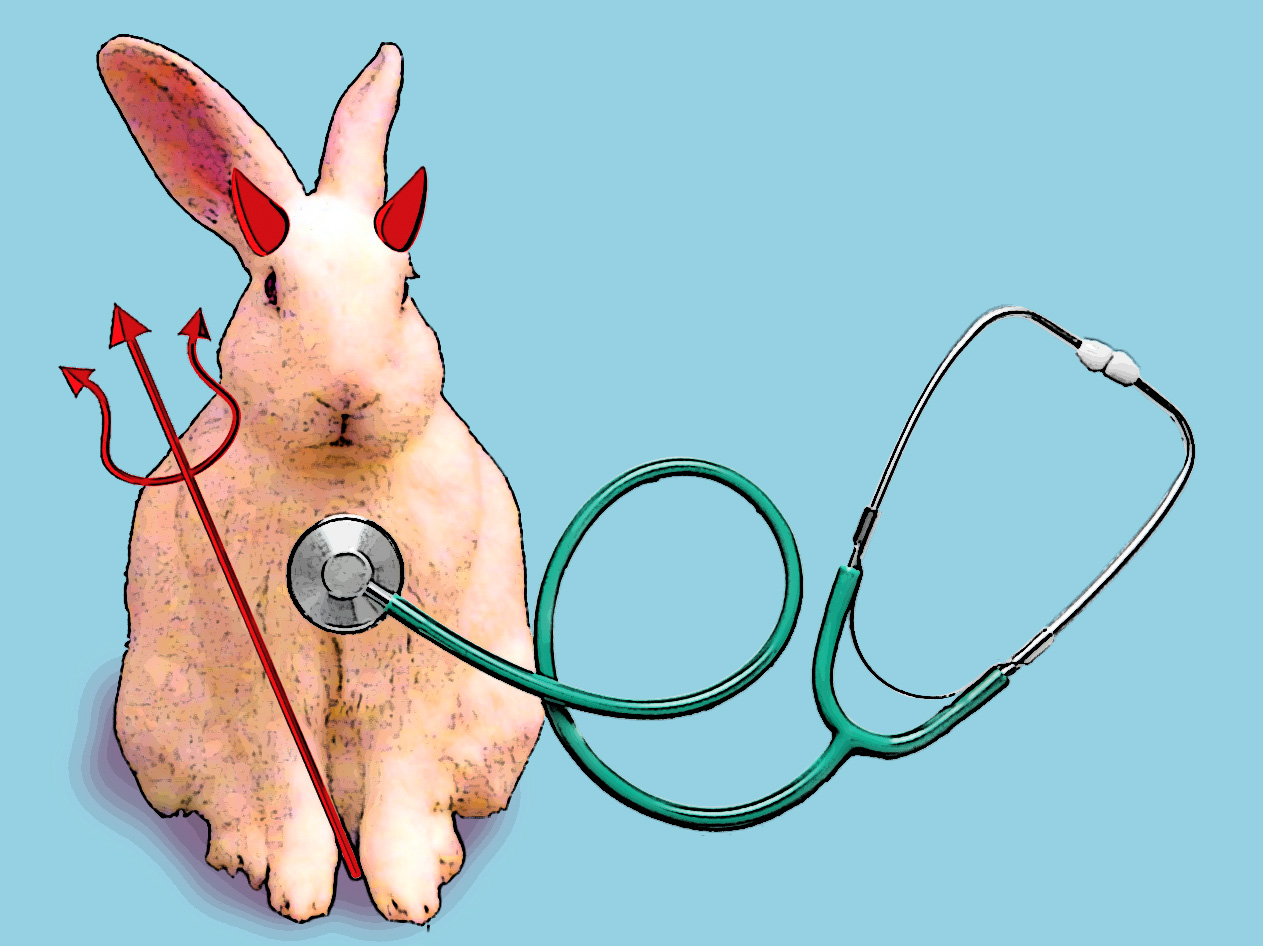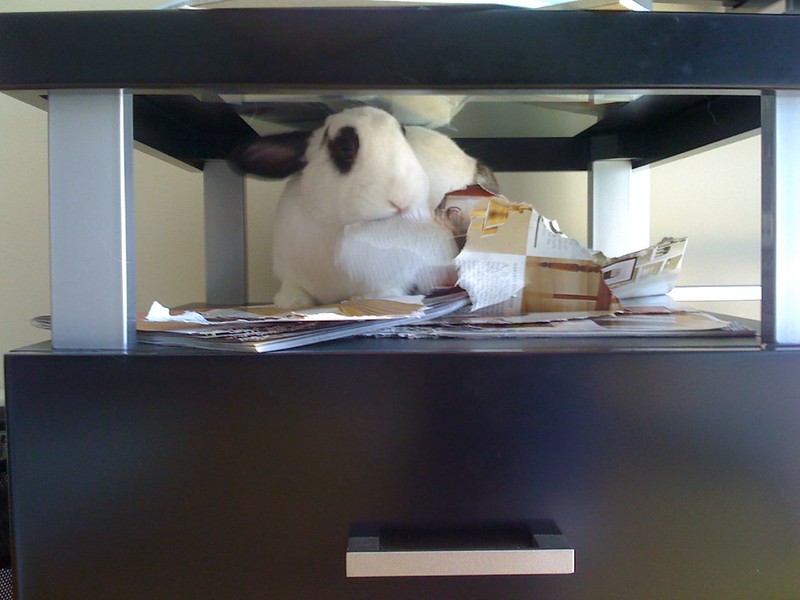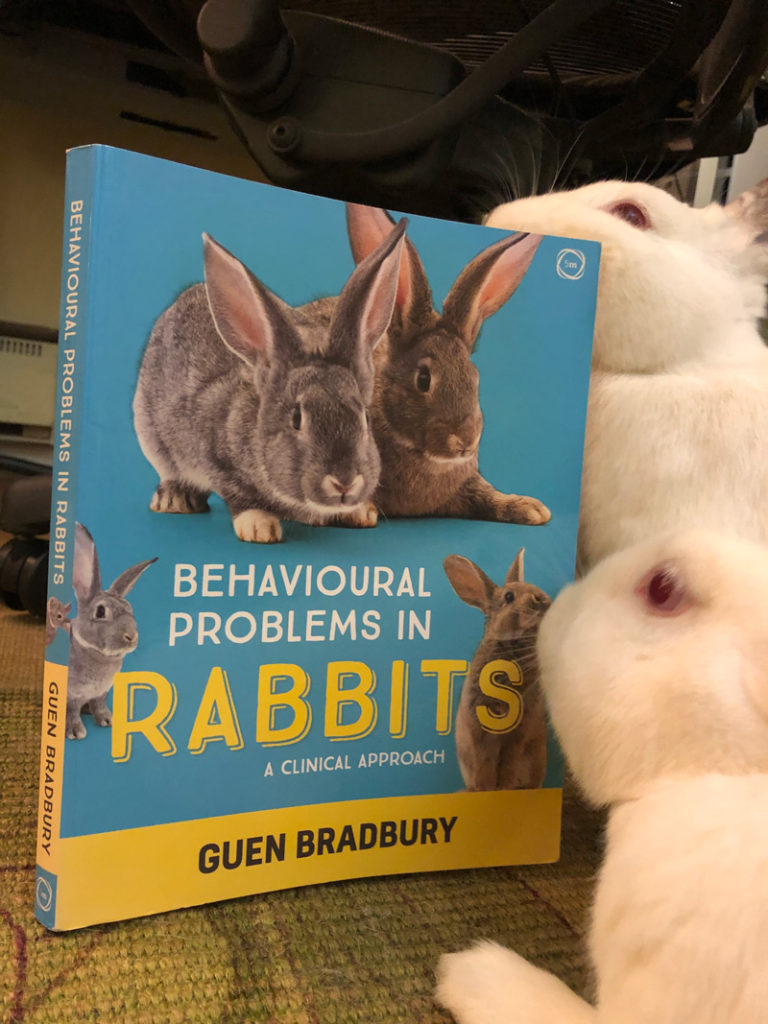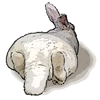
Your rabbit is peeling the wallpaper off your wall. How do you seek help? Talk to rabbit-lover friends? Call the rescue you adopted from? Google it?
Ever ask your vet?
Bun owners like me often consult a vet about a behavior that we suspect has a medical cause. One example is urination outside the litterbox. It’s sometimes thought to be caused by a bladder infection, so the vet is the obvious person to consult. However, recently I discovered that some veterinarians can also be of help with behavior concerns that aren’t directly linked to an illness or injury.
The Role of the Vet Behaviorist

Veterinary behaviorists are vets who supplement their basic training with an animal behavior specialty . They diagnose potential causes, and prescribe whatever treatment best fits the situation; whether it’s medication, training, or management strategies. With a vet behaviorist on staff, a vet office becomes a one-stop shop for both medical and behavioral approaches to solving problems.
Wow! Wouldn’t it be great if you could get help from your vet with your bun’s outside-the-box peeing that wasn’t caused by an infection? Why had I never heard of this before?
There are two possible reasons. One is that not every vet office has a vet behaviorist on staff. Secondly, most vet behaviorists in the U.S., like most vets, earn their credentials without ever learning anything about treating rabbits .
So even if your vet office includes a behaviorist, chances are they’ve got little to no experience with rabbits. If you are super lucky you may find one near you who does, but where does that leave the rest of us when our spike-eared chum goes rogue and starts shredding the sofa cushions?
Dr. Bradbury to the Rescue!
Enter Behavioural Problems In Rabbits: A Clinical Approach, by Dr. Guen Bradbury. Dr. Bradbury is a veterinary behaviorist in the U.K. who took a deep interest in rabbits. While she was in veterinary school, her father passed away and left her Pewter, the pet rabbit that he loved. But from day one, Pewter showed aggression towards anyone who interacted with him, frequently by biting them.
“Pewter was miserable and it showed in his behaviour. Trying to help him started my exploration of clinical behavioural problems in rabbits – a subject on which I’ve since published many articles, authored a textbook, lectured, and done many webinars…. Dad loved rabbits – I really wish he could see all this.” — Dr. G. Bradbury, in an interview
Dr. Bradbury’s book (the textbook she mentions above) is clearly a labor of love for this species which is so often misunderstood and underserved. Don’t let “textbook” put you off. You don’t have to be a veterinary student to get something valuable from this book.
For example, Dr. Bradbury spends a good deal of time on proper rabbit diet. Humans eat a wide range of different foods every day for good health, but as the book explains, a healthy rabbit diet is much more constrained to just grass, hay and leafy vegetables. Furthermore, to a rabbit, this is sufficient variety. It gives them the right balance of nutrients, and rabbit taste buds can detect a lot more flavors among that limited set of foods than ours can. (p.32-33)
 Finding the Root Causes (and Cures) for Problem Behavior
Finding the Root Causes (and Cures) for Problem Behavior
The book examines all aspects of the rabbit’s lifestyle, environment and diet for anything that might be causing stress. Stress can induce all sorts of behavior from obsessive bunstruction all the way to lunging, growling, or biting. It doesn’t take much imagination to understand why stress influences behavior, not just for rabbits but for any animal.
Take me, for example. For five months last year I was in an internship program learning to be a dog trainer. Every week I had to complete about 20 hours of homework, reading, classes, and dog training practice, in addition to working my full-time job.
Given that, what do you think it was like for my husband to share a 2-room apartment with me? I was grouchy, overly sensitive, and a couple of times I broke down in tears. When I finished the program, it was like a ten-ton weight was lifted off my shoulders.
Well, the same thing happens to your rabbit if something is causing him stress. Of course you would never intentionally stress out your bunny! But something may be happening you hadn’t thought of.
For instance, the book explains that feeding high calorie foods to rabbits can cause stress. This is because a healthy diet of hay and grass takes longer to consume. Without the task of finding and munching lots of tasty hay to keep him amused, a bunny gets bored! Seeking new entertainment, he starts pulling all the fibers out of your carpeting. Rich food can also cause tummy aches, which surely can make a bun irritable, and therefore more prone to take out his aggressions on objects, or less open to being approached or touched. (pps. 24-39)
So something as simple as changing your rabbit’s diet to reduce the amount of treats and cereals and increase the grass and hay might actually result in him losing interest in eating your work boots. Thanks to this book, I have gotten much more restrictive regarding what I feed my guys. In particular, they get a lot less cereal, and they get it in the form of training treats or puzzle toys rather than laid out for them to simply gobble up. Housing, health, and interactions with other members of the household are also potential stressors that could be causing behavior issues.
In that vein, I have long and firmly believed that it’s perfectly fine to keep a domesticated rabbit indoors at all times. Letting them outside makes me nervous. There are just too many things out there that could harm them! But, in addition to getting a good dose of Vitamin D, this book convinced me that the daily pleasures of grazing grass and exploring the outdoors could actually be a cure for rabbit misbehavior.
Unfortunately, I have no outdoor space to offer in my high-rise apartment. But, should I ever have a back yard, I will probably start giving my bunnies a little very securely fenced and continuously supervised outdoor playtime every day. That wallpaper stripping I talked about? It could well be solved by providing the opportunity to strip bark off branches, a very popular past time amongst our fluff-tailed friends. If I can let them go outside, I don’t have to drag a tree limb into my living room.
 And Even More Good Stuff
And Even More Good Stuff
Training is another way to reduce stress and boredom. The book includes a section on training that can give you a good grounding in basic concepts, such as what motivates rabbits, why punishment is not effective, what foods to use for training rewards, and how to use them. It also describes a number of husbandry-related training exercises to work on, such as training your bun to let you pick her up or let you take a look at her toenails to see if they’re too long.
As a bonus, the appendix includes 13 very concise and clear “advice sheets” with step-by-step blueprints for things like improving the bunny’s environment, litter training, and bonding. I’m particularly intrigued by the “Constructional Approach Training” sheet. This is a technique for establishing rapport with a very timid or skittish bunny that gently allows him to get comfortable with human contact. It keeps the person’s presence at a level where the rabbit is not distressed, and reinforces the bun when he shows signs of relaxing. The how’s and why’s of the approach are covered in detail earlier in the book, and the advice sheet provides a concise reference to guide you through the process. I’ll definitely be pulling this one out next time I encounter a bun like that.
The attention to detail in the book’s design is the icing on this very informative cake. Its pages are adorned with simple, charming drawings of rabbits and their tiny footprints as they hop through the content.
 The Fluffy Tail of This Blog Post
The Fluffy Tail of This Blog Post
I think Behavioral Problems in Rabbits: A Clinical Approach is an excellent read for any rabbit enthusiast. It gives us all a wonderful opportunity to learn what a rabbit behaviorist might tell us in person if we had one nearby to consult. It will be a resource I’ll refer to again and again as I continue my journey living with rabbits.
Amy Nieh says:
Yay!! Sounds so interesting and educational! Just only my copy from a UK bookstore ♥️
Melinda says:
That’s great! I hope you find it as useful and informative as I did!